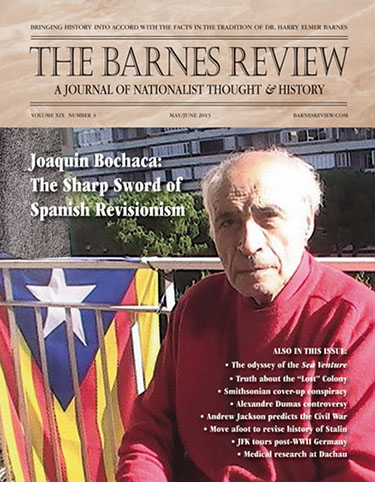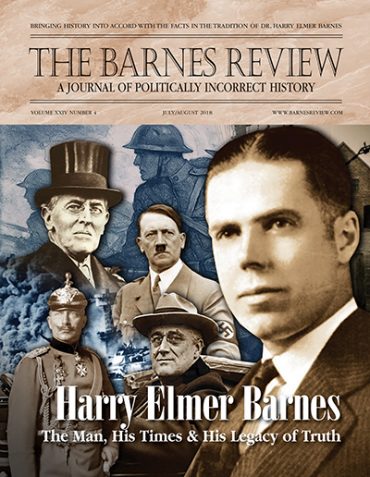
The Barnes Review, May/June 2013
$5.00 – $10.00
The Barnes Review
A JOURNAL OF POLITICALLY INCORRECT HISTORY
May/June 2013 ❖ VOLUME XIX ❖ NUMBER 3
TABLE OF CONTENTS
THE SHIP THAT SAVED JAMESTOWN?
THE TRUTH ABOUT THE “LOST” COLONY
THE SMITHSONIAN CONSPIRACY
ANDREW JACKSON’S SECOND INAUGURAL
THE ALEXANDRE DUMAS CONTROVERSY
TIME TO REVISE THE HISTORY OF STALIN?
JFK VISITS WAR-RAVAGED GERMANY
MEDICAL EXPERIMENTATION AT DACHAU
THE SWORD OF SPANISH REVISIONISM
TRUTH ON THE SCAFFOLD
- Description
- Additional information
Description
The Barnes Review
A JOURNAL OF POLITICALLY INCORRECT HISTORY
May/June 2013 ❖ VOLUME XIX ❖ NUMBER 3
TABLE OF CONTENTS
THE SHIP THAT SAVED JAMESTOWN?
By John Tiffany. It was called “the Starving Time,” that brutal winter of 1608/1609 at the Jamestown colony in Virginia during which 75% of the settlers there died from disease, Indian attack and lack of food. Luckily, a relief fleet of five ships, led by the Sea Venture, was sent with supplies. Unluckily, that fleet passed through what some scholars today believe was a category five hurricane. They not only ended up making it through (albeit a bit delayed) to save the Jamestown colonists from starvation, they also claimed Bermuda for the British in the process—all on the same inspiring odyssey.
THE TRUTH ABOUT THE “LOST” COLONY
By Scott Dawson. More than 20 years before Jamestown was even settled, Europeans were trying to establish a permanent colony on the Outer Banks of North Carolina. But relations with some of the natives turned sour and, when relief ships were finally able to make it to the Roanoke Island settlement—years late—the little fort town was abandoned. Thus it is now ubiquitously called “the Lost Colony.” But clues tell us that the colony was never really lost at all. And that they have, in fact, been under our noses for more than 400 years.
THE SMITHSONIAN CONSPIRACY
By Philip Rife. The Smithsonian has an enormous collection of artifacts housed in 19 museums and nine research centers, so big in fact it appears the curators cannot keep their trinkets straight. Interestingly, though, the Smithsonian seems to “lose” more politically incorrect historical finds than any other type. Author Philip Rife explains why that is.
ANDREW JACKSON’S SECOND INAUGURAL
By President Andrew Jackson. Last issue TBR published Andrew Jackson’s first inaugural address. There was a lot of interest expressed by readers in the old populist hero, so we have decided to publish Jackson’s second inaugural address. Though short, it contains much information—and a prediction of civil war.
THE ALEXANDRE DUMAS CONTROVERSY
By William White. Everybody loves the books of French writer Alexandre Dumas, The Three Musketeers and The Count of Monte Cristo being two of them. No doubt he was a talented man, but just how much of the classic literature of Dumas was pirated from his collaborator, Auguste Maquet?
TIME TO REVISE THE HISTORY OF STALIN?
By Daniel W. Michaels. Many Russian scholars and politicians want to see the tarnished legacy of Josef Stalin shined up a bit, some even suggesting he should be know as “Stalin the Great.” But can this mass murderer be called “great” in any way?
JFK VISITS WAR-RAVAGED GERMANY
By John Nugent. While still a young senator, John F. Kennedy visited warravaged Germany. What he had to say about the Soviet occupation, Allied conduct and Adolf Hitler may surprise you.
MEDICAL EXPERIMENTATION AT DACHAU
By John Wear. So exactly what were German doctors doing at the Dachau prison camp? The mainstream tells us that whatever these doctors did was a “holocaust” in and of itself. But is this the truth? And what were U.S. doctors doing at the time?
THE SWORD OF SPANISH REVISIONISM
An Interview with Joaquin Bochaca. While in Spain, TBR’s Margaret Huffstickler got the chance to spend some time with famed Catalonian Spanish Revisionist Joaquin Bochaca, whose writings have graced the pages of TBR for years. Here is Margaret’s interview with “the Sword of Spanish Revisionism.”
TRUTH ON THE SCAFFOLD
A Poem by James Russell Lowell. Here’s a fact filled poem, originally written by a waffling abolitionist, but with great pertinence today for patriots and historians.
Additional information
| TBR Back Issue | PDF Copy, Print Copy |
|---|







